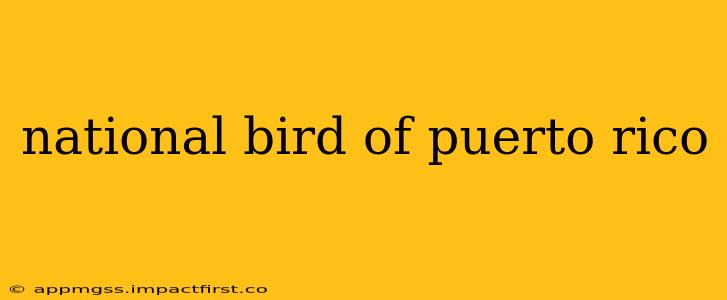The vibrant island of Puerto Rico, a jewel of the Caribbean, boasts a rich history, culture, and biodiversity. Its national bird, the Puerto Rican Tórtola ( Zenaida aurita), also known as the Puerto Rican Zenaida Dove, is more than just a pretty face; it's a potent symbol of the island's identity and a testament to its commitment to conservation. This gentle dove, with its understated elegance, embodies the spirit of Puerto Rico.
What is the National Bird of Puerto Rico?
The national bird of Puerto Rico is officially the Puerto Rican Tórtola (Zenaida aurita). While often simply called the Zenaida Dove, specifying "Puerto Rican" is crucial, as several subspecies of the Zenaida Dove exist throughout the Caribbean and Americas. The Puerto Rican subspecies holds a unique place in the hearts of the island's people.
What makes the Puerto Rican Tórtola special?
The Puerto Rican Tórtola isn't just any dove; it's endemic to Puerto Rico, meaning it's found nowhere else in the world. This endemism makes its conservation all the more vital. Its plumage, a soft blend of browns and grays, provides excellent camouflage in its natural habitat. It's easily recognizable by its small size, delicate build, and the soft, cooing sounds it produces, which are a common soundtrack to the island's landscape.
What is the significance of the Puerto Rican Tórtola as the national bird?
Choosing a national bird is a symbolic act, reflecting the values and spirit of a nation. The Tórtola's selection speaks volumes about Puerto Rico's connection to nature and its commitment to protecting its unique biodiversity. Its gentle nature and peaceful demeanor resonate with the island's spirit, offering a counterpoint to the often-turbulent historical context. It's a symbol of hope, resilience, and the enduring beauty of the island.
What are the threats to the Puerto Rican Tórtola?
Despite its symbolic importance, the Puerto Rican Tórtola faces several threats, highlighting the ongoing need for conservation efforts. Habitat loss due to deforestation and urbanization is a major concern. Furthermore, the introduction of invasive species and the impact of climate change also pose significant challenges to the Tórtola's survival. These pressures underscore the importance of ongoing conservation initiatives designed to protect this vulnerable species and its habitat.
What conservation efforts are in place to protect the Puerto Rican Tórtola?
Various organizations and government agencies are working diligently to safeguard the Puerto Rican Tórtola. These efforts include habitat restoration projects, public awareness campaigns to educate the public about the importance of conservation, and strict regulations to control hunting and poaching. Research into the Tórtola's population dynamics and the impact of environmental changes is crucial in informing and guiding these conservation efforts. The success of these initiatives is essential for ensuring the future of this beloved national bird.
Where can I see Puerto Rican Tórtolas?
You have a good chance of spotting Puerto Rican Tórtolas throughout the island. They are relatively common in various habitats, including forests, scrublands, and even urban areas. Visiting national parks and other protected areas will significantly increase your chances of observing these beautiful birds in their natural environment. Remember to respect their habitat and observe them from a distance to avoid disturbing them.
The Puerto Rican Tórtola isn't merely a pretty bird; it's a symbol of national identity, a testament to the island's unique biodiversity, and a call to action for conservation. Its continued survival depends on the collective efforts of the people of Puerto Rico and the international community dedicated to protecting its natural heritage.
